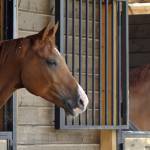Housing Situation: Single Life May Stress Out Horses

Some horses housed individually in stalls experience intense stress recognized by measurable changes in white blood cells, increased cortisol levels, and behavior changes. When subjected to this level of stress, horses may be at risk of becoming immunosuppressed, which could increase their susceptibility to disease.
“Horses are regularly housed in individual stalls. Such management limits access to their peers, thereby compromising their natural social needs and changing their feeding behaviors,” explained Catherine Whitehouse, M.S., a Kentucky Equine Research nutrition advisor.
To determine how quickly horses become stressed and what the effect of chronic stressors are, 12 two- or three-year-old German Warmblood geldings were recruited. All horses were maintained in social groups on pasture for eight weeks prior to the start of the study. Horses were then moved to individual box stalls that allowed tactile and visual contact with other horses. The horses were managed similarly in terms of feeding management and exercise.
Researchers collected blood samples about one week prior to being moved to individual stalls as well as one and eight days after stalling began. White blood cells were measured in each sample and compared. In addition, cortisol was measured immediately prior to being moved to the individual stalls and then again one and eight days afterward. Behavior patterns were also assessed one week after relocating to the individual stalls to identify any stereotypic behaviors.
“Substantial changes in white blood cell parameters were observed one day after relocation,” Whitehouse said.
Specifically, the total number of neutrophils increased by 25% while other types of white blood cells that play important infection-fighting roles decreased one day after relocation. Those “other” white blood cells included monocytes, eosinophils, T helper cells, and cytotoxic T cells, which decreased by 16-31%. In addition, the neutrophil-to-lymphocyte ratio was significantly increased one day after relocation. Each of these alterations was typical of a stress response in horses, according to the study authors.
“Cortisol levels, a common measure of physiologic stress, significantly increased on day one following relocation to single housing. Levels did, however, return to normal by day eight,” Whitehouse shared.
In terms of behavior, horses demonstrated “pre-stages of stereotypy-related behaviors” one week after being moved from group housing on pasture to single housing. Of the 11 evaluable horses, 10 showed oral manipulation of objects not related to food uptake, nine exhibited neighing, stamping, and pawing—behaviors related to social or contact deprivation and frustration. Apathetic behaviors, such as standing flat to the wall, were observed in 9 of the 11 horses.
The researchers therefore concluded that relocation to single housing leads to acute stress-induced modulation of the immune system as evidenced by the increased neutrophils and decrease in other white blood cells. Those changes were accompanied by early stereotypy-related behaviors. Such a relocation was therefore deemed an intense stressor that may immunocompromise horses housed in such scenarios.
“When individual housing or changes in housing cannot be avoided, consider adding nutritional supplements that provide digestive and immune health support. Make sure you are providing a well-fortified diet with adequate amounts of essential amino acids and trace minerals. Look for products that contain natural-source vitamin E, vitamin C, and digestive health components such as buffers,” advised Whitehouse.
Nano-E is a powerful antioxidant that plays a vital role in immunity. This water-soluble formulation uses nanotechnology to create a rapidly absorbed and available natural source of vitamin E.
*Schmucker, S., V. Preisler, I. Marr, K. Krüger, V. Stefanski. 2022. Single housing but not changes in group composition causes stress-related immunomodulations in horses. PLoS One 17(8):e0272445.








